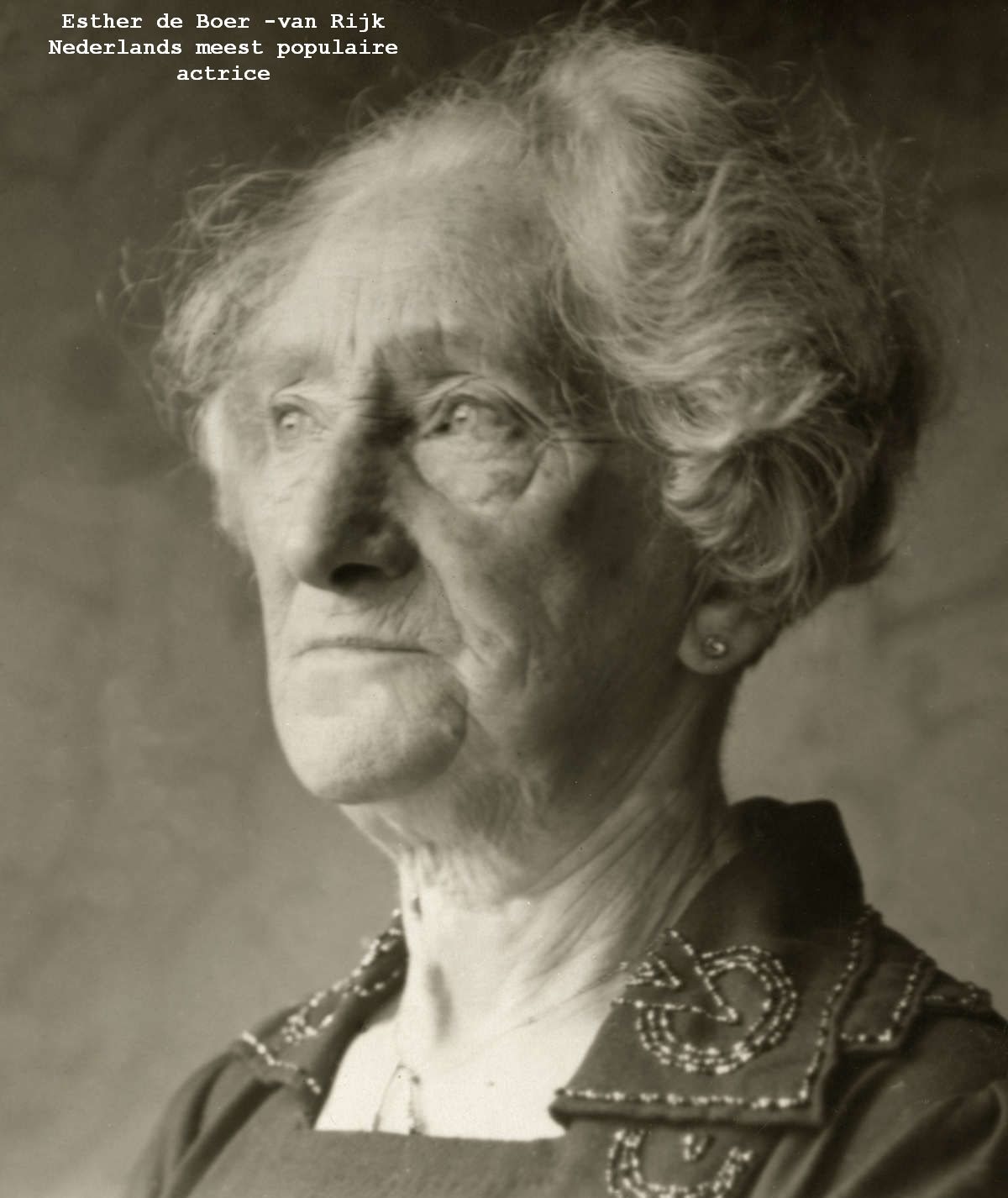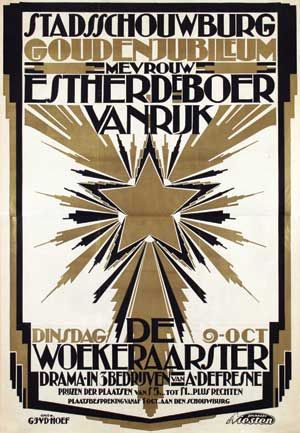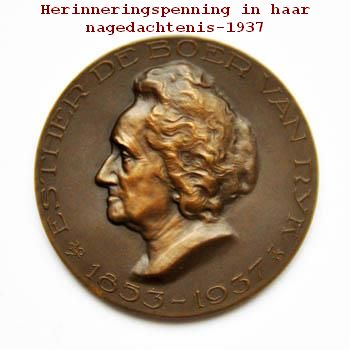Esther de Boer-van Rijk
Esther de Boer-van Rijk was born in Rotterdam, 29th of July, 1853, and was possibly the most famous actress of all times in the Netherlands.
Certainly she was the most famous Dutch actress of Jewish descent.
Her parents were Moses van Rijk, a clerk and Adriana Wolfhart, a seamstress. Esther was the fourteenth child in a simple, poor Jewish-orthodox family – not all these children survived. Her father died when Esther was only eight years old, and the burden of caring for the family fell on the shoulders of her mother. Esther was called Hes by her relatives and friends. She married in 1881 a musician, Henri de Boer, who was chronically ill for many years and died in 1917. They had one daughter, Sophie de Vries-de Boer, who was an actress as well, and who perished in Auschwitz.
Esther van Rijk was expected to follow in the footsteps of her mother and to become a seamstress. At a young age she tended to love acting and she did that very well. Her parents were very unhappy with the prospect of their daughter going to the theatre, coming as she did from an orthodox milieu, and the reputation of actresses at the time was far from flattering, deserved or not. Ultimately her talent was recognized, and Esther started appearing with amateur theatre groups. She learned 'modern' acting while still in Rotterdam at the theatre group of Antoine le Gras, where feelings were expressed; this in contrast to the heavy 'schmiere' on-stage that was customary in those days.
Notwithstanding the attempts, especially by the outspoken wish of her father to keep her from her calling, she became a professional actress in 1873.
Her professional debut took place in Rotterdam in the play Emma Berthold by Jacob Jan Cremer. After her marriage she moved to Amsterdam. She appeared with the Nederlandsche Toneelvereeniging, later De Toneelvereeniging. The first play by Herman Heijermans that she acted in was 'Ghetto' in the Hollandse Schouwburg. From then on she was the leading lady in almost all the plays by this famous Dutch playwright.
Her triumph as actress was no doubt her role as Kniertje, the old widow of a fisherman who perished at sea, in the successful play Op Hoop van Zegen by Herman Heijermans (see his biography in the triptych at Akevoth, coming soon) which premiered on Christmas eve 1899. From then onwards she filled this role more than 1200 times; her strength was that every time on stage she 'lived' the role, a sentiment that she knew to transfer to her audience time and again. The play was made into films on several occasions, in 1918, still a 'silent' film and 1934 a 'talky'; Esther was the star in both of these. In 1924 a film was made in Germany under the title: 'Die Fahrt ins Verderben'. The play has stood the test of time, and is shown in theaters from time to time until this very day.
The play had an enormous impact when it first was performed, especially since the author Heijermans studied and knew the abominable conditions at sea fishery. The play is a moving accusation against a social evil. He wished by his play to force the unscrupulous ship-owners to desist from their nefarious practice, by knowingly sending unseaworthy 'floating coffins' to their doom in order to rake in the insurance monies. Esther's convincing rendition of the pains and misery of the women who live with the fishing world contributed hugely to effectuate a change. And indeed, in 1909 a ships-law was passed, which made control of all outgoing vessels mandatory. This certainly was due to Heijermans' serious efforts to improve the lot of the fishermen, and Esther played no small role in this achievement.
Her relationship with Heijermans was possibly at times more than a working partnership. Heijermans was no unconditional admirer of her acting skills, and he expressed his opinion openly as early as 1916: 'This great artist is great in depicting the petit bourgeois milieu, in the atmosphere that I loved in several plays. Yet, in the romantic or in the classical repertoire or in salon-plays … she falls short more or less'. Whatever the critics wrote, the public loved her. Even in less successful sentimental plays, she knew how to convince her audience, because of her serious approach to all her roles. After the groups she worked with did not survive financially, Esther formed her own theatre companies that bore her name, sometimes with great financial difficulty. She was invited to play with existing theatre companies in the Netherlands and abroad. She personified Kniertje in England, where she said her part in Dutch, while all other actors spoke English. Her acting was so convincing that the play became a great success. The name of the play in English is usually rendered as 'Trusting our fate in the hands of God'.
Esther gave many benefit performances for refugees from the Nazi-regime and to promote the treatment of tuberculosis. She was sympathetic to the Zionist movement.
She was honored during her lifetime in many ways, the most important events to be mentioned, are:
on the occasion of her 70st birthday, in 1923, she was named by the city of Amsterdam a 'Citizen of Merit' and was presented with a silver medal of honor.
In 1928 she was promoted to Knight in the Order of Orange-Nassau,
and in 1929 Knight in the Crown-order of Belgium.
In 1934 she published her autobiography: 'Ik kijk terug" (I look back).
Until her last days she appeared onstage. She died in Amsterdam on the 7th of September 1937, and was buried two days later. The interest of the public at her funeral was overwhelming: tens of thousands of mourners lined the route from the Stadsschouwburg, via the Hollandse Schouwburg, and on the Middenweg on her way to the Muiderberg cemetery.
The record of her grave can be found in de Muiderberg database of Akevoth , index nr. 19.884,00 – location of her grave:- D,H,173.
The Jewish Historical Museum of Amsterdam has just now (at the time this article was written) presented an exhibition on her life and achievements, running from 19th of May 2014 until 28th of September 2014, under the title: Holland's most popular actress Esther de Boer-van Rijk.
This short biography was prepared by Eldad Kisch, from different sources. For more extensive information, consult the new biography that was published this year by Joosje Lakmaker in the Wereldbibliotheek:
Paperback, 304 pages
Published 2014 by Wereldbibliotheek
ISBN 9789028425514
edition language: Dutch
 |
||||
 |
||||
 |
 |
|||
 |
||||